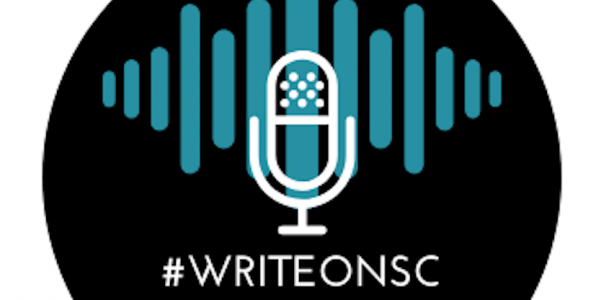On July 27th Kasie and Rex welcomed back Mary Sturgill to promote the SCWA’s Fall Retreat and to discuss where and how to begin a short story. Here are the show notes:
Theme for the day
Short Story — Beginnings
Agenda
- The SCWA’s Retreat is coming up!
- Short Story Basics
- Structure of a short story — how it begins

Segment 1
Let’s start with some Retreat details and review the opportunity our listeners have before them: The Fall Retreat is in Beaufort and coincides with the Pat Conroy Literary Center’s Conroyfest Annual event. Links to both events here and here.
What is the Retreat and why should people go? Highlights:
- A full-day craft intensive writing workshop led by one of five nationally-known authors each with their own super power.
- Open Mic, Slushfest, and Member-Expert Workshops.
- All-events access to the Pat Conroy Literary Center’s Annual Conroyfest.
- Yoga on the Green, a run through downtown, and fellowship with other writers.
We’re excited to have as faculty:
Megan Mayhew Bergman is the author of Birds of a Lesser Paradise, Almost Famous Women, and a forthcoming novel with Scribner. Her work has been published in the New York Times, New Yorker, The Guardian, Ploughshares, Paris Review, Oxford American, and Best American Short Stories.
Judy Goldman is the author of six books — two memoirs, two novels, and two books of poetry. Her new book, Together: A Memoir of a Marriage and Medical Mishap, was published by Nan A. Talese/Knopf Doubleday in February.
Jon Pineda is the author of the novels Let’s No One Get Hurt and Apology. His memoir Sleep in Me was a 2010 Barnes & Noble Discover Great New Writers selection. He is also a poet and the winner of the 2007 Green Rose Prize, and Birthmark, winner of the 2003 Crab Orchard Award Series in Poetry Open Competition.
Dana Ridenour is a retired FBI Special Agent who spent most of her career as an undercover operative. Dana’s first novel, Behind The Mask, won numerous literary awards and was named one of the Best Indie Books of 2016. Her second novel, Beyond The Cabin received the 2018 Royal Palm Literary Award for Best Thriller or Suspense Novel.
Jason Ryan is a nonfiction author and journalist in Charleston, South Carolina. His books include the marijuana smuggling tale Jackpot: High Times, High Seas and the Sting that Launched the War on Drugs, the true crime thriller Hell-Bent: One Man’s Crusade to Crush the Hawaiian Mob, and the early aviation account Race to Hawaii: The 1927 Dole Derby and the Thrilling First Flights That Opened the Pacific.
So a great mix of genre, poetry, nonfiction, memoir, and fiction. Super excited to meet each of these folks and get some quality instruction with them on Friday.
What will they teach? Here are the write-ups:
Megan Mayhew Bergman (fiction writer) Megan likes writers to begin with knowing themselves – imagining what kind of work they most want to create. Students will spend time connecting with their unique gifts and passions, combing through stories only they can tell. Starting from that place, writers in the workshop will focus on technique – like dialogue, character development, mood, and structure – and generate content through writing exercises. To conclude, we’ll move into the practical space of thinking about how to launch work into the wider world, and connecting with readers.
Judy Goldman (memoir) In this workshop (geared to both beginning and advanced writers), you’ll learn how to craft your personal essay or memoir into something others will care about. We’ll discuss compelling openings, voice, the difference between scene and summary, dialogue, the importance of reflection, how much to reveal about people close to you, how to keep going even when you think you’re about to step off the edge of the world. There’ll be time for publishing tips, as well. To help you discover your most engaging material, we’ll do writing exercises in class and share the results.
Jon Pineda (poetry) Building Images and The Element of Surprise In this poetry workshop, we will discuss various strategies for constructing vivid images and imagery in our poems. Utilizing Frost’s advice of “No surprise for the writer, no surprise for the reader,” we will practice crafting images (starting at the word-level and building from there) that utilize sensory details, strengthen the voice, and, ultimately, engage our readers.
Dana Ridenour (crime novelist) This full-day intensive training will be divided into two sections and will include one or more writing exercises.
- Session One is entitled: Dispelling the Myths of the FBI/What writers get wrong. This workshop will focus on the myths and clichés perpetrated by television and movies regarding the FBI. Writers will learn how to avoid the common pitfalls of writing FBI characters. The discussion will give writers a peak into the daily life of an FBI agent focusing on the FBI undercover program, the role of the FBI plays in terrorism and human trafficking investigations, and the FBI’s approach to chasing serial killers.
- Session Two is entitled: How to Write Believable Law Enforcement Characters/Crime Scenes/Fight Scenes. Law enforcement personnel are an integral part of crime fiction. Their roles range from those enforcing the law at street level up to the upper echelons of command. This discussion will include: The psychological toll of being a law enforcement officer, how to write realistic law enforcement characters and crime scenes, writing about firearms, understanding jurisdiction, writing realistic fight scenes and turning your real-life experiences into fiction. It will also delve into the importance of research.
Jason Ryan (creative nonfiction) Though I specialize in narrative nonfiction, I’m passionate about all types of original writing. I’d like to spend time at the retreat getting our hands dirty and taking a nuts-and-bolts-approach to writing samples, figuring out how pieces might become stronger and pack more punch. I’d also like to talk generally about long-form writing, and how to sustain feature-length and book-length pieces. For those passionate about narrative nonfiction (writing true stories that read like novels), our discussions can touch on effective interview and research techniques, as good source material is crucial for good nonfiction storytelling.
Early Bird Pricing ends next Wednesday, so go to MySCWA.org and get registered today. There’s information on hotel and other things there as well.
Saturday is the Pat Conroy Literary Center’s Conroyfest event and we’ll have access to all of that through the SCWA Retreat. Read what’s on that agenda here. Kasie’s bestie Jonathan was on the show back in June on episode 48 (show notes here) and they talked about Pat’s influence on South Carolina’s literary scene.
Segment 2
So July has been Short Story month kicked off by us talking about how the short story is an American contribution to the literary canon. Don’t believe us? Try these links: The Origins and History of the American Short Story which argues it’s like jazz music; Encyclopedia Brittannica which says other words for it — sketch, tale — are indicative of the form’s evolution; and Wikipedia (of course) which says Hawthorne’s Twice Told Tales legitimized the form by collecting multiple stories and publishing them together.
Then last week we talked about the way to end a short story (show notes here) both of us eschewing the ambiguous ending and the twist ending but debating (rather spiritedly!) the merits of the abrupt or unresolved ending.
This week we’re going back to the beginning (Princess Bride clip here). We should totally do a show on movies that are based on books.
Anyway, the beginning of the short story doesn’t have the same luxuries as the beginning of the novel. You can’t meander your way in. You can layer in the exposition, set the scene, build the world. You have to get right to it.
Start in the middle. In media res — right in the middle of the action.
Mark O’Bannon recommends starting at the end in this blog. He says starting at the end will help you get these questions answered:
- What is your story about? What is the purpose of your story?
- What is the main character’s goal? The desire forms the spine of the story.
- How does the opponent come in conflict with the hero’s goal? It is better to think of it as the hero and opponent competing for the same goal, rather than the opponent interfering with the character’s goal.
- Will the hero or the opponent win? Not all heroes succeed in their quest. The opponent sometimes wins.
- What is the hero’s main character flaw? The weakness will form the heart of the story.
- How can you demonstrate this weakness in the beginning of the story? Show how the character flaw is ruining the hero’s life.
- How does the opponent come in conflict with the hero’s character flaw? For instance, if the hero is ambitious, the opponent might appeal to the character’s pride.
- How will the hero overcome his character flaw and realize his need? The weakness is gradually revealed over the course of the story, and it becomes obvious to the hero near the end. This is called the self-revelation.
Segment 3
Great opening lines are one way to hook your reader. Here are a few ideas from this blog 8 lessons from great opening lines:
- Leave the reader wanting to know more. — Reference something that’s already occurred or the gravity of the existing condition.
- Introduce the novel’s central theme. — this is the “kiss” we talked about before; the ending should kiss the beginning and the beginning should help us understand what the story will be about. What’s the theme? Weave it into the opening line. “It was the best of times, it was the worst of times.” Right?
- Make a bold statement. Then help the reader understand what you mean by it. This one from Anna Karenina: “Happy families are all alike; every unhappy family is unhappy in its own way.” YEAH THEY ARE. Let’s commiserate. Or OH REALLY? PROVE IT. Either way, I’m hooked.
- Set the story in motion. The first line could be the fatal action the protagonist takes to ensure the rest of the story occurs.
- Set the tone — lay in the narrative voice. If you’re speculative, let that first line speculate. If you’re snarky, let that first line be snarky. The voice matters. Especially in a short piece.
Ready to support Write On SC? Go to Patreon.com/WriteOnSC to become a patron!

3 Comments Add yours